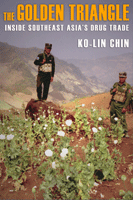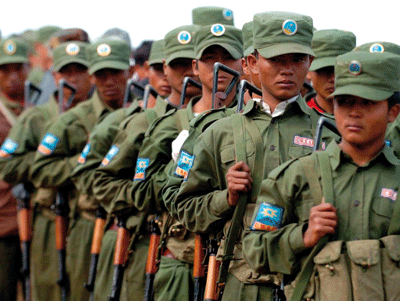 BURMA’S United Wa State Army is seen by many Western law enforcement agencies as one of the most powerful drug-trafficking organizations in the world. Since signing a cease-fire agreement with the Burmese government in 1989, the 20,000-strong UWSA has been granted control of Wa Special State—an isolated and mountainous region of Shan State in Burma’s northeast that produces the lion’s share of the heroin and methamphetamines in today’s Golden Triangle.
BURMA’S United Wa State Army is seen by many Western law enforcement agencies as one of the most powerful drug-trafficking organizations in the world. Since signing a cease-fire agreement with the Burmese government in 1989, the 20,000-strong UWSA has been granted control of Wa Special State—an isolated and mountainous region of Shan State in Burma’s northeast that produces the lion’s share of the heroin and methamphetamines in today’s Golden Triangle.
Although Western media reports paint a picture of a region in the grips of local drug lords and “narco-armies,” what little is popularly known about the Wa people themselves doesn’t extend much beyond their one-time penchant for slicing off the heads of their enemies—that is to say, not a lot. Evidence of the drug trade in the Wa hills remains scarce, and few Western researchers have been able to gain access to the region. Mr. Chin’s nuanced account of drug production, trade and enforcement in the region, fills in some of the gaps in the record. Between 2001 and 2006, Mr. Chin, a professor of criminal justice at Rutgers University, conducted over 400 interviews with people working at all levels of the drug trade in Wa State, from the impoverished villagers who collect the opium sap to the government officials and Chinese entrepreneurs (often one and the same) involved in its process and export. The result is a multilayered portrait of the drug trade, and a convincing argument that standard law-enforcement techniques will be largely ineffective—even counterproductive—against the Golden Triangle drug trade.
The defeat of drug lord Chan Chifu (also known as Khun Sa) by a UWSA-Burmese army assault in 1996, Mr. Chin observes, has merely led to the proliferation of new kingpins in the region, who continue to flood Thailand with millions of yaba—low-cost methamphetamine pills. Similarly, a 2005 opium ban declared by the Wa authorities in response to international pressure was quickly offset by a spike in yaba production. Recent reports even indicate that the ban may be collapsing; in 2007, the United Nations Office of Drugs and Crime estimated Burma still produced around 460 metric tons of raw opium, much of it in Wa State. One reason for this, Mr. Chin argues, is that the distinction between the drug trade, politics and legitimate business simply doesn’t exist. Drug profits support everything, from villages in the remote highlands to the construction of roads, schools and other basic infrastructure. “In the Wa hills,” he writes, “the question of whether a person is a drug lord or political leader, a drug producer or a businessman, [is] irrelevant.”
In 2005, Bao Youxiang, overall leader of the Wa State, and the UWSA’s southern commander Wei Xuegang were both indicted by a United States Federal Court for heroin and methamphetamine trafficking. But these two “kingpins,” Mr. Chin argues, have also helped fund roads, schools and other infrastructure in the Wa State. Caught in the aspic of poverty and repression that is modern Burma, and largely isolated from the outside world, drug money has become the primary engine of state-building. The Wa State and its people simply can’t do without it.

The United Wa State Army is the largest ethnic army in northern Burma.
Another reason for the failure of traditional drug-enforcement methods is that the drug trade is closely entwined with regional politics. Indeed, the Wa and Shan minorities have often functioned as proxy forces in the hostilities between Bangkok and the Burmese junta, for whom stability in its combustible hinterlands is a higher priority than drug control. As one local official described it, the Wa were being blamed for the drug problem “because the Thai government wanted to demonize the Wa after [we] refused to be their ally in their war against the Burmese government … It’s really not about drugs.”
The historical presence of Han Chinese in Shan State—especially in Kokang, Mengla and the Wa hills—also provided an easy bridge into the Chinese drug market when it blossomed after the market reforms of the 1980s. While the ethnic Wa provide the “muscle” of the drug trade and foot soldiers for the UWSA, the “brains” of the operation are predominantly ethnic Chinese. Prior to the 1990s, most of the Golden Triangle’s heroin reached the international market via Thailand and Hong Kong; today the supply lines trace inward, through Yunnan province, Guizhou province and Guangxi Zhuang Autonomous Region, and hence to Guangzhou, Hong Kong and the international market.
Although Mr. Chin does not describe it as such, The Golden Triangle is also the story of the neighborhood effects of China’s galloping economic resurgence. With the opening of the “China route,” the country has also become a large drug market in its own right, and heroin use has spiked. This is especially the case in Kunming (the capital of Yunnan), where cheap Golden Triangle heroin now supports a large migrant addict population from across inland China. As of 1999, China’s National Narcotics Control Commission employed 17,000 specialized antidrug officers nationwide, and Chinese leaders have increased their pressure on the ethnic Chinese leaders of Wa State to crack down on drug production—with mixed results.
Mr. Chin closes the book with a call for a “multinational and multi-discipline” approach to narcotics, pushing the obvious point that drug enforcement in Burma has little chance of success unless it is based on finding a political solution to the festering conflicts between Rangoon and its periphery. In the words of Chao-Tzang Yawnghwe, a Shan prince turned Western academic: “It is not merely being idealistic, nor is it wishy-washy liberalism, to say that Burma’s drug problem and its solution require measures that will restore a functional relationship between state and broader society in Burma.”
For those unfamiliar with modern Burmese history and politics, however, the book may appear confusing, and though the author aptly describes the situation as it is, there are a lot of gaps in his telling of how it got that way. His historical backgrounder on the Wa area in the second chapter, for instance, falls into a retelling of the Wa “tradition” of headhunting—a piece of historical arcana largely irrelevant to the task at hand—while it is only in the second to last chapter that the reader learns of the Burmese government’s policy toward drug eradication.
But these are small quibbles, and the author’s sheer tenacity in laying bare the workings of the Burmese drug trade makes this book unique. While he is not the first observer to make the argument for a more multifaceted approach to antidrug efforts, The Golden Triangle succeeds in furnishing it with a convincing new body of evidence. It is Mr. Chin’s interview subjects—such as the aspiring drug dealer who spent months trekking to remote villages to collect raw opium, and the drug users in Tachilek and Kunming who use the end product—who give a familiar argument added force.
[Published in the Far Eastern Economic Review, June 2009]




1 comment
Tun says:
Jul 11, 2011
it’s the Chinese which the international community must put the pressure on, that’s of course if they truly gives a damn about Burma.
China is Bad News for Burma, and Junta and the Chinese have made a deal where China exercises its Vito in ASEAN to protect Burma, which allows the Junta to go mental and in return the Chinese gets all produce of burma, like that dam, for the hydropower.
The twist is that a lot of International community have far too much investments in China, such as manufacturing facilities, and in a nut shell have no balls left to subjectively argue with China, and coupled that with the attitude of who gives a damn what happens inside Burma, really, when the have put themselves in a situation where they are economically shit scared of China.
Just my point of view.
Of course, India and Russia are not to be forgotten…